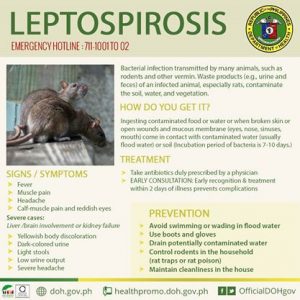NewsDesk @bactiman63
The Philippines is reporting a significant increase in leptospirosis cases so far in 2023, according to the Philippines Department of Health.

From January 1 through March 4, 807 leptospirosis cases were reported throughout the country. This is a 210 percent increase compared to the same period in 2022 (260 cases).
The Western Visayas (Region VI), which includes Aklan, Antique, Capiz, Guimaras, Iloilo and Negros Occidental provinces has reported the most cases with 176, followed by the Cagayan valley region (Region II) with 103 cases.
In addition, the death toll due to the bacterial infection to date has increased 65 percent, from 43 last year to 71 this year.
Leptospirosis is a bacterial disease. People (and animals) can get infected when they are exposed to the urine of infected animals. They can also get infected from water, soil, or food contaminated with infected animal urine. Leptospirosis bacteria can enter the body through skin or mucous membranes (eyes, nose, or mouth).
Subscribe to Outbreak News TV on YouTube
To reduce your individual risk, it is important to understand that exposure to animals, soil, mud, and floodwaters during work or recreational activities increases your risk of infection.
Symptoms include fever, chills, headache, muscle aches, vomiting, stomach pain, diarrhea, jaundice (yellow eyes and skin), red eyes, and skin rash. Without treatment, leptospirosis can lead to kidney damage, meningitis (inflammation of the membrane around the brain and spinal cord), liver failure, respiratory distress, and even death.
Vietnam issues alert over Streptococcus suis infections
Taiwan reports H9N2 avian influenza on poultry farm
Measles outbreak in Nepal: Nearly 700 cases recorded
Hand, foot and mouth disease in the Philippines: Iloilo and Bacolod City
- Vietnam: Rabies deaths reported in Lao Cai province
- Nigeria diphtheria outbreak: More than 1,000 suspected cases reported from 21 states
- Vermont, Maine, and New Hampshire experience largest percent change in Babesiosis incidence
- Paraguay: Chikungunya epidemic has spread throughout the country
- Russia: Two people hospitalized with anthrax in Chuvashia
- Burundi declares polio outbreak, First cases reported in more than three decades

